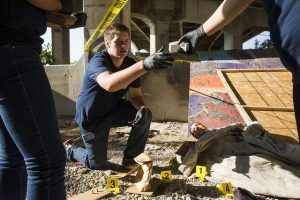It’s the Season Premiere of CSI: Central Campus

Students in the new criminal justice program at Central Campus are getting a hands-on lesson with the investigation of a mock homicide.
“An anonymous call came in at 0330 hours. The caller was male and reported a dead body under the overpass behind Central Campus. The deceased is a white male. There’s a lot of blood, he said. Then he hung up.”
That’s how Criminal Justice instructor Greg Gourd (“Tech Gourd”) greeted his class this morning in Room 3402. And so began an investigation that will be the basis for a yearlong curriculum in an exciting new Career Tech program at Central Campus.
Gourd is retired from a 30-year career in forensics with the Des Moines Police Department. He’s a pro at what he’s teaching. So is the head of the program, Captain Kelly Willis, also retired from DMPD. Thursday morning they divided their class into Teams A, B and C and proceeded from the initial briefing in their classroom to the crime scene they’d contrived and taped off out back. There the eager, inquisitive students took notes, made sketches, gathered and tagged evidence…the usual cop stuff, all under the experienced guidance of Willis, Gourd and a bevy of former colleagues still on the force.
There was a corpse (actually, a poor unidentified mannequin who never really lived). There was what appeared to be blood. There was a handgun, the apparent murder weapon. But things aren’t always what they seem, the students were cautioned. There were footprints and fingerprints. Instead of working toward final exams the CJ student-investigators will compile and submit comprehensive crime scene reports to Tech Gould.
Central biotech teacher Kacia Cain was on the scene as an observer. Eventually her students and the CJ students will collaborate on cross-curricular DNA analyses. This program, like the investigation that launched today and will be ongoing throughout the year, is just getting started. Those who complete it will earn, yes, earn, up to 16 hours of college credit at DMACC and a leg up on careers in law enforcement and emergency response.
Which is precisely what Carson Jones was hoping for when he signed up for these classes. Jones is a junior at Roosevelt who just moved here a year ago from Colorado. He has an uncle who’s a police officer and he knew that’s what he wanted to do with his life. But he never thought he’d be able to start in high school.
“Last spring I was talking with a counselor and I shared my career plans. She told me the criminal justice program would be starting this year and there were only two spots (out of 18 in this first year) left. So I’m lucky I got in,” Jones said Thursday morning while donning latex gloves so as not to contaminate the crime scene. “So far it’s been great; very hands-on and interactive.” Then off he went to role play as an evidence custodian.
Collectively the class was fired up as a football team that’s tired of practicing and ready for its opening game. But the instructors make a point of tempering the enthusiasm for the stuff of TV crime dramas. Another DMPD retiree, Steve Howell (who works now in security for DMPS), took great pains to explain to the students that what the CSI shows don’t show is the tedious, meticulous mountains of paperwork that are the guts of police work. Howell served from 1995-2008 as one of the Midwest’s first Victim Resource Officers. As a VRO, he told the kids, he was charged with informing families that a loved one had been killed and dispelling rumors they might hear during the course of an investigation.
“It gets to you after a while, always having to deliver bad news,” he said. “You hear that old saying about ‘don’t kill the messenger;’ well, I’ve seen big strong men fall to their knees and sob and I’ve been attacked by tiny, grieving women. You are dealing with people at tough times in their lives.”
While Howell spoke to one team another was checking out the innards of a patrol car and the third was inside the tape, poring over evidence sifted from the sand and cigarette butts. Everybody wore t-shirts emblazoned with two logos: DMPD and Central Campus. It was all realistic enough to draw the curiosity of passersby. The only giveaway that this wasn’t what it appeared to be at first glance was when everybody paused for a group photo, grinning. That’s not part of the protocol at the scene of an actual homicide.
“Oh, we will solve this case,” Willis assured a questioner. And he promised the emergence of some surprise suspects as the students follow the trail of evidence. But it’s not open-and-shut. It’s still early in the school year, after all, and besides, justice is not always swift.
In the meantime, let’s break it up, folks. Go on about your business. We’ll keep you posted on the mock murder at Central Campus.




